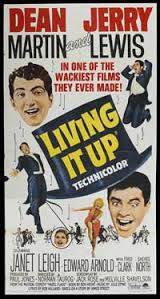
LIVING IT UP
US, 1954, 95 minutes, Colour.
Dean Martin, Jerry Lewis, Janet Leigh, Fred Clark, Edward Arnold, Sheree North.
Directed by Norman Taurog.
Nothing Sacred was in the tradition of wacky comedies of the '30s featuring such stars as Carole Lombard. Here she encounters Fredric March in a story of satire on New York paper exploitation of victims, especially those considered sentimental, and the heroine here is about to die.
However, it is a mistake and there are all the workings of the cover-up. William Wellman, who made A Star Is Born at this time, keeps the pace moving and it is one of the early Technicolor films. The humour and the satire are quite effective.
It was remade and reworked as a Martin and Lewis comedy in the 50s - Living It Up. This time the satire is on the nuclear threat and radiation. Jerry Lewis has the Carole Lombard role and Janet Leigh has the Fredric March role. It is quite humorous and has the usual routines. Living It Up was directed by Norman Taurog who directed a number of Martin and Lewis comedies in the 50s.
1. The meaning and overtones of the title, the way that it was illustrated?
2. Audience expectations from Dean Martin and Jerry Lewis comedies? The comedy styles of the two actors, their blending? Dean Martin's singing and the contribution of the songs? Jerry Lewis's songs, the atmosphere of his clowning, the type of foolishness and comic aspects of human nature that he represents? The use of colour? New York, Desert Hole?
3. The significance of the film's being a remake of the 1930s classic comedy, Jerry Lewis taking the part originally written for Carole Lombard? The reversal of male-female roles?
4. How plausible was the plot, the atmosphere of reality and unreality? The making of a comedy out of a potentially tragic situation, about a confidence trick?
5. The humour of the opening, Desert Hole, radioactivity and people's reaction? The establishing of the character of Homer Flagg, of Steve? Homer and his work at the railway station, his feeling closed in, his wanting to move out of it? Steve as a would-be doctor?
6. How was the character of Homer presented throughout the film? A mixture of shrewdness and stupidity? The routines of comedy, the way that he used the money, throwing the baseball, the Jitterbugging, the hospital routine where he pretended to be the various nationalities?
7. The contrast with Steve and his style, his going to New York, falling in love with Hally, trying to keep the confidence trick going, the dilemma about marrying Hally? The quality of the relationship between Homer and Steve?
8. How attractive was Hally? Her role at the newspaper, her commercialisation, her arrival in Desert Hole and the satire on the west? Her tearfulness and compassion for Homer, even to marriage? Her exploiting this to the newspaper? Her reaction to the truth and to the story she planned for the ending?
9. The character of Oliver, the satire on the newspaper magnate, all his money being spent, his reaction at the end? The satire in the presentation of the mayor, especially in welcoming Homer and at the wedding ceremony, the grand procession at the end?
10. The contribution of the minor characters: the visiting doctors, people at the jitterbugging? The hotel people? How much of a satire on the world of medicine?
11. The jitterbugging sequence and the style of the 50s?
12. The development of the plot, the satire on medical films, on radioactivity, on confidence tricks? The build-up to the climax and Homer's going into the river? The irony of the ending, after Steve and Homer doing their song and dance routine in the streets of New York?
13. How well do these comedies come over decades after their production?